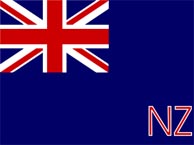New Zealanders debate two flags
 Wellington - New Zealanders have long debated changing their national flag, which prominently features Britain's Union Jack as a constant reminder of its colonial background, for something more typical of today's independent South Pacific state.
Wellington - New Zealanders have long debated changing their national flag, which prominently features Britain's Union Jack as a constant reminder of its colonial background, for something more typical of today's independent South Pacific state.
The flag also bears the four stars of the Southern Cross constellation and is easily confused by foreigners with Australia's standard, which is almost identical but for six stars.
Campaigners for a new national flag favour using a stylised kiwi - the flightless, nocturnal bird whose name New Zealanders are happy to use as a nickname for themselves - or the silver fern emblem widely used by the country's sports teams.
Either of these would immediately identify New Zealand in the same way Canada's maple leaf flag affords immediate recognition of that country, they argue.
In the face of opposition from diehard conservatives, successive governments have evaded the issue and the centre-right administration elected in November seems certain to leave it firmly on the shelf.
But now, the country's indigenous Maoris, who account for about 15 per cent of the 4.3 million population, have begun a series of tribal meetings to decide their own flag.
And they appear to be equally divided between the old and the new.
The question flared up two years ago when authorities who routinely fly flags of foreign countries on top of Auckland's landmark harbour bridge on national days turned down a request to fly a Maori flag alongside the New Zealand one on February 6.
On that day in 1840, representatives of Britain's Queen Victoria and Maori chiefs signed a treaty at Waitangi in the Bay of Islands. It is regarded as the country's founding document and Waitangi Day is commemorated every year as New Zealand's national day.
Prime Minister John Key defused the anger of Maori activists by saying they could fly a Maori flag not only on the bridge but on all public buildings if the 40-odd Maori tribes could agree which flag they wanted flown.
His Minister of Maori Affairs, Pita Sharples, accepted the challenge and this week launched the first of 21 consultation meetings with tribes around the country in search of agreement.
"I am very happy to be asking Maori communities for their views on a national Maori flag," he said. "This is the first time it has ever been done and we are really excited about that."
The Maoris have three options - two historical and one modern, which seems to be the front runner from a sample of responses from Tuesday's first meeting in Auckland, published in the New Zealand Herald newspaper.
Known as the tino rangatiratanga, or Maori sovereignty flag, it won a competition in 1989, a time of Maori cultural renaissance.
It has a black band at the top, representing the darkness from which the world emerged, and a red band at the bottom, depicting the earth. They are separated by a white band, representing the physical world and in the shape of a traditional Maori "koru," or unfolding fern leaf.
Its main challenger is an 1834 flag chosen by a confederation of northern tribes which was used as the official flag of New Zealand until it was replaced by the British Union Jack when the Waitangi treaty was signed.
It features a red St George's Cross on a white background with another red cross on blue and four white stars in the top left-hand quarter.
The New Zealand Red Ensign, one of the first flags to be flown by New Zealand ships, is the third choice. It was often given to Maoris by Queen Victoria or the British government as a reward or thanks when a tribal or ancestor's name was worked into the design.
Sharples said he personally favours the tino rangatiratanga flag because it "looks and feels Maori," but he reassured European New Zealanders suspicious of its adoption by Maori sovereignty activists.
Europeans should not feel threatened by the idea of Maoris celebrating their heritage, he said. "Basically, a lot of people are monocultural and think being one people means being like them - it doesn't mean that at all.
"Being one people means accepting our differences. They think that because you're pro- one thing you're anti- another. I am very pro-Maori but my father was a Pakeha (European).
"I'm certainly not anti-Pakeha and it doesn't make me anti-Pakeha to be fighting for my Maori flag," he said. (dpa)